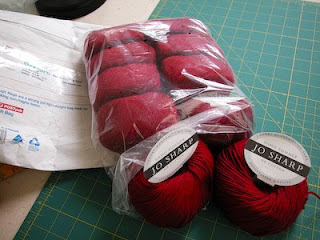
This post contains a free pattern for the Oregon Summer Beach Scarf which is based on a stitch pattern described by Barbara Walker, in A Treasury of Knitting Patterns, as the right diagonal version of "Diagonal Faggotting Stripe Pattern." The pattern is suitable for advanced beginners.
The yarn used in the model, from Yarnia in Portland, OR, is a fingering/sock weight yarn composed of three untwisted strands of different fibers. You can order online from their website. You'll want to buy 6 oz. of fingering/sock weight composed of cotton combined with rayon, linen, or silk. For more on the yarn and a close-up photo see my previous post.
 What I would really like to see as the knitter trying to make this scarf, though, is more of the pattern graphed. Seeing several motifs side by side would help me to grasp the repeat and how it flows in the finished item. The repeat between the two vertical, colored bars of the stitch pattern can be inserted in the graph any number of times. Below is what the graph looks like when the repeat is duplicated the same the number of times that it is used in the 52-stitch-wide scarf.
What I would really like to see as the knitter trying to make this scarf, though, is more of the pattern graphed. Seeing several motifs side by side would help me to grasp the repeat and how it flows in the finished item. The repeat between the two vertical, colored bars of the stitch pattern can be inserted in the graph any number of times. Below is what the graph looks like when the repeat is duplicated the same the number of times that it is used in the 52-stitch-wide scarf.
Before I provide the link for the free PDF file, I want to say a little bit about knitting pattern instructions and my goal when providing patterns for my designs.
Historically, pattern instructions have been composed primarily of written words which are given in row-by -row instructions. Usually the author or publisher is nice enough to begin the instruction for each row of knitting on a separate line of type so you can follow along using a ruler or a sticky note.
At other times, the row-by-row instructions are all bunched together in paragraphs with little regard for presenting the knitter with a page layout which would aid in following the instructions. For me, a non-auditory learner, this is the printed equivalent of a lecture. All the information is there, but it's difficult, or at least time-consuming, to grasp if your primary learning mode is visual.
Many designers now give a visual chart of the pattern motif that shows one repeat of the stitch pattern and the beginning and end-of-row stitches. This is a better approach to only giving us visual learners written instructions. The Oregon Summer Beach Scarf has a 10-stitch x 20 row repeat and a total of 12 stitches making up the beginning and end stitches. Here is what the single motif graph would like:
 What I would really like to see as the knitter trying to make this scarf, though, is more of the pattern graphed. Seeing several motifs side by side would help me to grasp the repeat and how it flows in the finished item. The repeat between the two vertical, colored bars of the stitch pattern can be inserted in the graph any number of times. Below is what the graph looks like when the repeat is duplicated the same the number of times that it is used in the 52-stitch-wide scarf.
What I would really like to see as the knitter trying to make this scarf, though, is more of the pattern graphed. Seeing several motifs side by side would help me to grasp the repeat and how it flows in the finished item. The repeat between the two vertical, colored bars of the stitch pattern can be inserted in the graph any number of times. Below is what the graph looks like when the repeat is duplicated the same the number of times that it is used in the 52-stitch-wide scarf.Isn't that better? In this graph you can more clearly see where you're headed as the knitter.
Let's go one step further and think about the repeat as it feels to the knitter in action. The repeat is not what appears between the two vertical bars, which in Chart A changes on every row.
The repeat is the sequence of stitches "(K2tog, YO) twice, K6". Looked at this way, the repeat is not vertical, but diagonal. Showing only one "repeat" as in Chart A is barely adequate and asks me to think harder than I want while also watching TV or a baseball game. In the knitting grid which follows, the repeats are color-coded alternately pale green and tan so that you can more easily see the repeating element as you knit the pattern.
In the free PDF pattern for the Oregon Summer Beach Scarf the chart is colored in the same way. I hope you like it.
Two additional pattern notes:
- The knitting graph and all of the written instructions appear on the same page.
- There is a progress box in the lower right corner of the page where you can keep track of how far along you are in the pattern by making a check mark every time you complete one 20-row repeat.


























